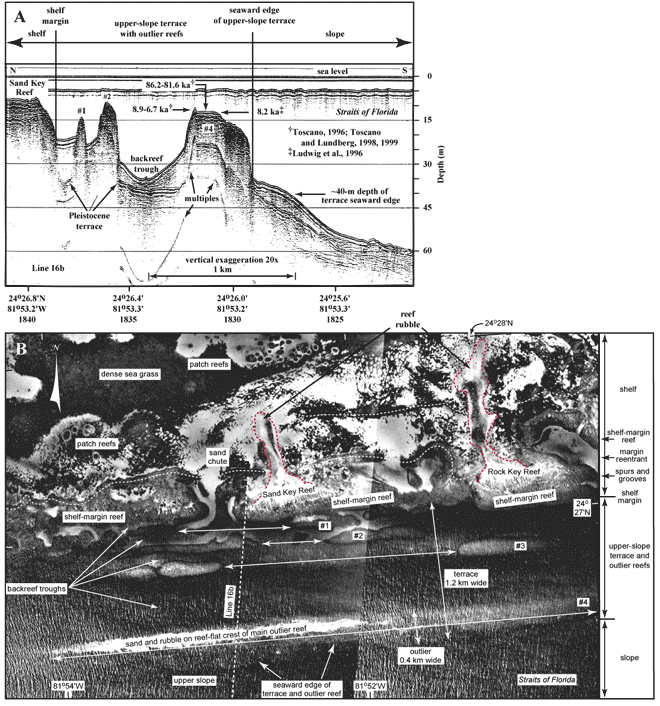FISC - St. Petersburg
Figure 106. (A) Original seismic documentation of three tracts of outlier reefs off Sand Key Reef southwest of Key West (Fig. 91B; from Lidz et al., 1991). Numbered reefs correspond to numbered tracts in (B). Largest outlier, cored and dated (Ludwig et al., 1996; Toscano, 1996; Toscano and Lundberg, 1998), developed at the seaward edge of a broad upper-slope terrace. Note discontinuity of the Holocene section on the reef crest (see Fig. 107A). Also note reflection representing nearly flat terrace surface between the largest outliers and lack of reflections beneath the reefs. Coral reefs and reef rubble typically obscure sound-wave penetration to underlying rock surfaces. 'Multiples' are an artifact common in seismic-reflection data. These reflections replicate those of existing, overlying, geologic surfaces and should not be regarded as representing any subsurface stratigraphic horizon. ka = thousands of years. Latitude and longitude in degrees and decimal minutes based on GPS coordinates. Hours (military time) below coordinates serve as navigational correlation points along seismic line. (B) Original aerial-photo documentation (1975) of four tracts of outlier reefs (#1-4) and their sandy backreef troughs (from Lidz et al., 2003). Seismic line 16b in (A) just missed tract #3, as shown on photo (B). Note discontinuity of Pleistocene shelf-margin reef, and discontinuity and hummocky outlines of outliers. Also note landward patch reefs, linear Holocene spurs and grooves at seaward edge of Sand Key and Rock Key Reefs, and ovate zones of storm-transported reef rubble (red dotted lines) behind the two reefs. White dotted lines mark outer-shelf coral-rock ridges (e.g., Figs. 79A, 87A). Compare with geomorphic features in areas of major margin reentrants (Figs. 49A, 67). This key photo, diagnostic of the actual number of outlier-reef tracts present, is courtesy of Jim Pitts of the Department of Transportation in Tallahassee, Florida.
|
Can't see the printable PDF version? Get the free Adobe Acrobat® Reader. |
